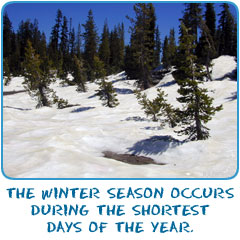What is a Year?
 You can pick up a calendar and see that a year is something that lasts from January 1 to December 31. After that, It starts over again. What is a year beyond dates on a piece of paper? A year is the time it takes the Earth to orbit the Sun one time. That time is equal to 365.24 days. You should know that it changes a little each year because when you travel 574,380,400 miles (924,375,700 km) sometimes you go a little faster or slower. Stuff happens along the way.
You can pick up a calendar and see that a year is something that lasts from January 1 to December 31. After that, It starts over again. What is a year beyond dates on a piece of paper? A year is the time it takes the Earth to orbit the Sun one time. That time is equal to 365.24 days. You should know that it changes a little each year because when you travel 574,380,400 miles (924,375,700 km) sometimes you go a little faster or slower. Stuff happens along the way.
As we move around the Sun, days change and four seasons begin to appear. Seasons exist because the Earth does not sit up and down. It's on a bit of a tilt. That tilt allows the day lengths to change throughout the year. Seasons with longer and warmer days are summers and the shorter and colder days are winters. The differences in the seasons are not as noticeable on the equator. As you move towards the poles, they become more and more extreme. Summers at the poles are almost entirely daylight and the winters are almost entirely night.

Leaping Like a Frog
Now you know a year is a little more than 365 days. A day is a little less than 24 hours long. All of this "little less" and "little more" adds up through the years. That leads s to the idea of leap years. Every four years we need to adjust our calendars. We add a special little day in February. Normally there are 28 days in February, but leap years give it 29 days. That extra full day makes up for the extra quarter days we gain every four years.Year Terms
A year is one unit. It's one trip around the Sun. We'll talk about months and days in the next sections. Let's look at some terms used to describe multiple years.Decade: Ten (10) years.
Century: One hundred (100) years.
Millennium: One thousand (1,000) years.
Light Year: The distance light can travel in one Earth year. (Almost 6 trillion miles)
There are also terms used to describe millions of years. These aren't exact numbers like a decade or century. These terms describe general geologic periods.
Eon: The longest amount of time.
Era: Several eras make up an eon.
Period: Several periods make up an era.
Epoch: Several epochs make up a period.
So where are we now?
Phanerozoic Eon - Cenozoic Era - Quaternary Period - Holocene Epoch - This Year - Today
We just thought you might like to know. It's like addressing an envelope.
Details to Remember
- There are 365 days in a normal year and 366 days in a leap year.- Four Seasons in a year (Winter, Spring, Summer, and Fall)
- A decade has ten (10) years.
- A century has one hundred (100) years.
- A millennium has one thousand (1,000) years.
Related Activities

|
Converting Minutes to Hours, Days, and Months
- Play Activity |

|
Learning the Names of the Months
- Play Activity |
Useful Reference Materials
Wikipedia:https://en.wikipedia.org/wiki/Pre-algebra
Encyclopædia Britannica:
http://www.britannica.com/topic/mathematics
College of the Redwoods:
http://mathrev.redwoods.edu/PreAlgText/





